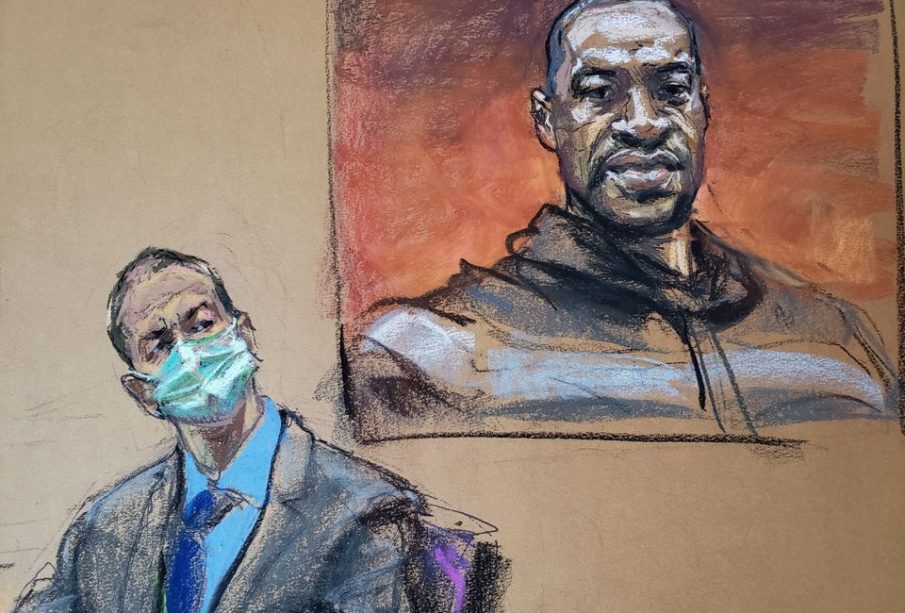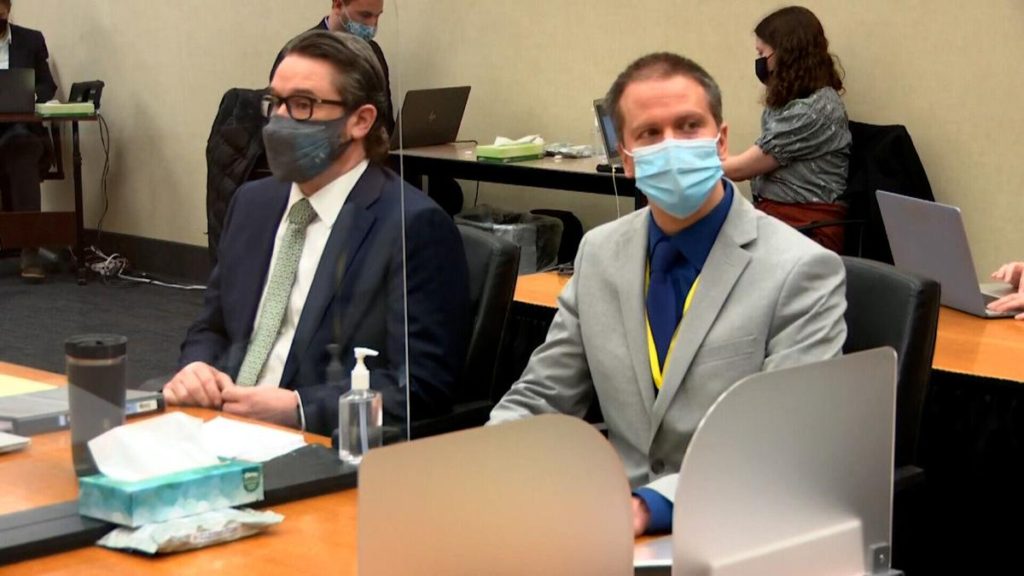Minneapolis ex-policeman Derek Chauvin found guilty on all counts in the murder of George Floyd
 Murder trial of former Minneapolis police officer Derek Chauvin. REUTERS
Murder trial of former Minneapolis police officer Derek Chauvin. REUTERSThe jury has found former police officer Derek Chauvin guilty on all counts in the murder of George Floyd last May.
Chauvin, 45, was found guilty of second- and third-degree murder and second-degree manslaughter.
The judge asked each juror if the verdict was correct, thanked them for “heavy duty jury service,” and dismissed them. He revoked bail and told Chauvin to report back in eight weeks for sentencing. Chauvin was handcuffed and taken into custody.
The former officer, who is white, was seen on video pinning George Floyd, a 46-year-old Black man, to the ground with his knee last Memorial Day for over nine minutes after police responded to a report that Floyd used a counterfeit $20 bill.
Cell phone video of the incident went viral and touched off months of protests in the U.S. and abroad condemning police brutality and calling for racial justice. The widely watched trial, which began in March with jury selection, was livestreamed – Minnesota’s first criminal case to be televised.
If convicted of the most serious charge, Chauvin faces 12 1/2 years or 150 months in prison under sentencing guidelines for a first-time offender. But, the prosecution argues there are aggravating factors that require a longer prison term. That means Chauvin may face longer than that sentence.
Throughout the trial, prosecutors argued that Chauvin’s knee – pressed against Floyd’s neck while he was handcuffed and face-down on the street – led to his death by loss of oxygen. The defense argued underlying heart issues and the methamphetamine and fentanyl in his system caused Floyd’s death while he struggled with police.
The prosecution rested its case last week after calling 38 witnesses and playing dozens of video clips over the course of 11 days. The defense rested Thursday after calling seven witnesses over two days. Attorneys for both sides presented their closing arguments Monday.
Floyd’s death prompted protests against racism and police brutality in many cities in the United States and around the world last year. The courthouse in Minneapolis was surrounded by high barricades and guarded by National Guard troops. Many downtown businesses boarded up their windows as they braced for the verdict.

While the U.S. criminal justice system and juries have long given leeway and some legal protection to police officers who use violence to subdue civilians, the jurors in this case found that Chauvin had crossed the line and used excessive force.
Under Minnesota sentencing guidelines, Chauvin faces 12-1/2 years in prison for his murder conviction as a first-time criminal offender. Prosecutors could, however, seek a longer sentence up to the maximum of 40 years if Hennepin County District Judge Peter Cahill, who presided over the trial, determines that there were “aggravating factors.”
In Minnesota, convicted criminals generally leave prison on supervised release after completing two thirds of their sentence. Chauvin had no previous criminal convictions.
Chauvin had pleaded not guilty to charges of second-degree unintentional murder involving “intentional infliction of bodily harm,” third-degree unintentional “depraved mind” murder involving an “act eminently dangerous to others,” and second-degree manslaughter involving a death caused by “culpable negligence.”
The jury included four white women, two white men, three Black men, one Black woman and two multiracial women, according to court records.
Earlier on Tuesday, U.S. President Joe Biden said he had spoken by phone with members of Floyd’s family.
“They’re a good family, and they’re calling for peace and tranquility, no matter what that verdict is. I’m praying the verdict is the right verdict, which is – I think it’s overwhelming in my view. I wouldn’t say that unless the jury was sequestered now, (would) not hear me say that,” Biden told reporters at the White House.
The intersection of race and law enforcement has long been contentious in the United States, underscored by a series of deadly incidents involving white police officers and Black people in a number of American cities in recent years.
The Minneapolis Police Department fired Chauvin and three other officers the day after Floyd’s arrest. The three others are due to face trial later this year on aiding-and-abetting charges in Floyd’s death.
MEDICAL EXPERTS
A cardiologist, a pulmonologist, a toxicologist and a forensic pathologist were medical experts called by prosecutors to testify that videos and autopsy results confirmed that Chauvin killed Floyd by compressing his body into the street in a way that starved him of oxygen.
The defense argued that Chauvin behaved as any “reasonable police officer” would have under these circumstances, and sought to raise doubts about the cause of Floyd’s death, saying heart disease or even the exhaust fumes from the nearby police car may have been factors.
Darnella Frazier, a teenager who told the jury she was taking her 9-year-old cousin to the Cup Foods grocery store that evening to get snacks, was among the witnesses called by prosecutors after jurors began hearing testimony on March 29.
Frazier had used her cellphone to make a video depicting Floyd’s excruciating ordeal, images that catalyzed the subsequent protests. Floyd can be heard on the video crying out for his mother and telling officers he could not breathe. Eventually Chauvin lifted his knee to allow paramedics to place Floyd’s limp body onto a stretcher.
Other eyewitnesses described the horror and lingering trauma of watching Floyd die in front of them. Courteney Ross, Floyd’s girlfriend of nearly three years, recalled their first kiss and their shared struggle with opioid addiction.
Minneapolis Police Chief Medaria Arradondo appeared as a prosecution witness to testify that Chauvin’s actions during the arrest represented an egregious breach of his training.
Throughout the trial, Chauvin, who was free on bail, wore a suit and took notes on yellow legal pads while sitting alongside defense attorney Eric Nelson. Members of Floyd’s family took turns attending the trial, though some tried to avert their gaze when video of Floyd’s death, recorded from multiple angles, was replayed to jurors.
The judge ordered the jurors to be sequestered after they began deliberations.
Courtroom seating was limited because of pandemic-related restrictions, leaving only single chairs at the back reserved for the families of Chauvin and Floyd. The Chauvin seat went mostly unclaimed until the final few days when at least two women began making appearances. Both declined to speak to reporters.
The judge let the proceedings be broadcast live to the public, a Minnesota first.
U.S. news networks carried much of the trial live, though the coverage was sometimes interrupted by new episodes of police violence caught on camera.
For example, a Black motorist named Daunte Wright was fatally shot on April 11 during a traffic stop in the Minneapolis suburb of Brooklyn Center. Wright’s death has also drawn international attention and raises the prospect of another Minnesota trial in which a police officer is accused of using excessive force.
SOURCE: REUTERS










